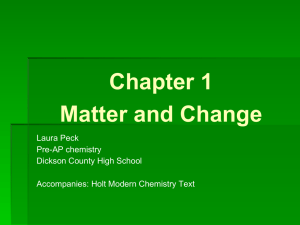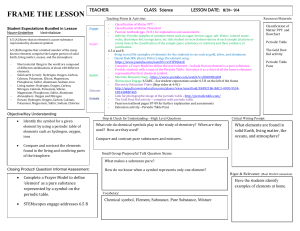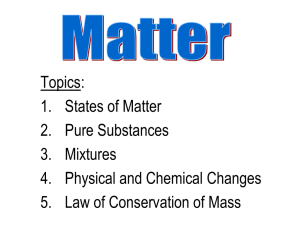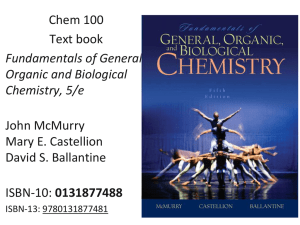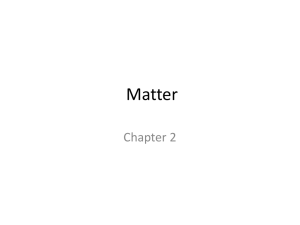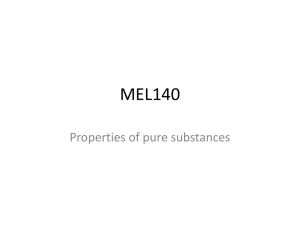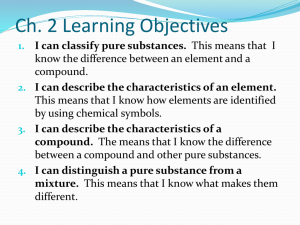1-B
advertisement
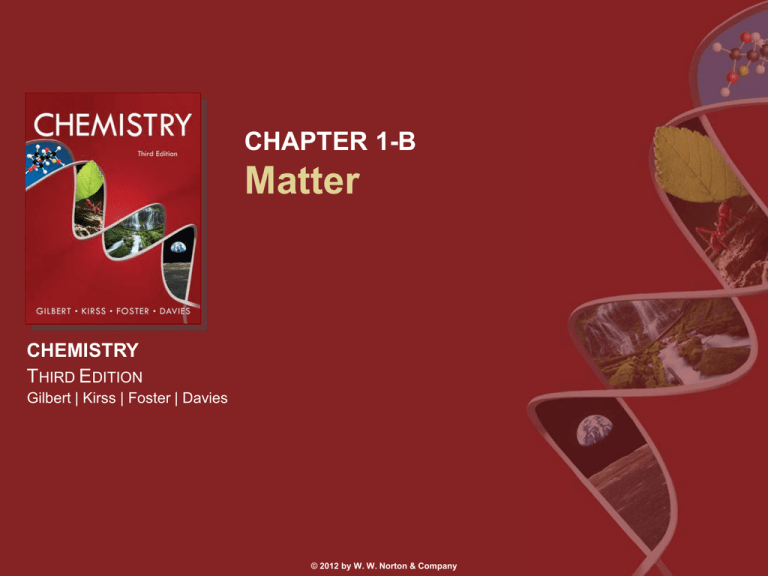
CHAPTER 1-B Matter CHEMISTRY THIRD EDITION Gilbert | Kirss | Foster | Davies © 2012 by W. W. Norton & Company Chemistry 2 Chemistry Chemistry: The science of matter and the changes it can undergo Ira Remsen’s Reaction: “Nitric Acid acts upon Copper.” 3 Ira Remsen “A most costly experiment…” 4 Ira Remsen Cu(s) + 4HNO3(aq) → Cu(NO3)2(aq) + 2NO2(g) + 2H2O(l) 5 Elements • A substance that consists only of atoms with the same atomic number. • Chemical Symbol: A collection of 1 or 2 letters used to represent an element. • First chemical symbols were assigned by John Dalton in 1803 (no longer in use) • Some modern chemical symbols: Hg, Zn, Mg 6 John Dalton 7 John Dalton 8 John Dalton’s Symbols 9 John Dalton’s Symbols 10 Chemistry and the Elements Names of Some Common Elements and Their Symbols Aluminum Al Chlorine Cl Manganese Mn Copper (cuprium) Cu Argon Ar Fluorine F Nitrogen N Iron (ferrum) Fe Barium Ba Helium He Oxygen O Lead (plumbum) Pb Boron B Hydrogen H Phosphorus P Mercury (hydrargyrum) Hg Bromine Br Iodine I Silicon Si Potassium (kalium) K Calcium Ca Lithium Li Sulfur S Silver (argentum) Ag Carbon C Magnesium Mg Zinc Zn Sodium (natrium) Na 11 12 Elements and the Periodic Table • Periods: The seven horizontal rows that group elements based on their principal quantum number. • Groups: The 18 vertical columns that group elements based on their angular momentum quantum number. 13 Elements and the Periodic Table 14 Elements and the Periodic Table • Main Groups: s-block elements: Two groups on the left (1 & 2) p-block elements: Six groups on the right (13–18) • Transition Metal Groups: d-block elements: Ten groups in the middle (3–12) f-block elements: Fourteen groups between 3 & 4 are called inner transition metals. 15 Elements and the Periodic Table 16 Elements and the Periodic Table 17 Elements 18 Elements 19 Elements 20 Elements 21 Elements 22 Properties of Matter • Matter: anything that has both mass & volume. • Properties: describe or identify matter. • Intensive Properties do not depend on amount. • Extensive Properties do depend on amount. 23 Properties of Matter • Physical Properties can be determined without changing the chemical makeup of the sample. • Some typical physical properties are: Melting Point, Boiling Point, Density, Mass, Touch, Taste, Temperature, Size, Color, Hardness, Conductivity. • Some typical physical changes are: Melting, Freezing, Boiling, Condensation, Evaporation, Dissolving, Stretching, Bending, Breaking. 24 Properties of Matter • Chemical Properties are those that do change the chemical makeup of the sample. • Some typical chemical properties are: Burning, Cooking, Rusting, Color change, Souring of milk, Ripening of fruit, Browning of apples, Taking a photograph, Digesting food. • Note: Chemical properties are actually chemical changes. 25 Properties of Matter PHYSICAL CHANGE PROPERTIES New form of old substance. No new substances formed. CHEMICAL Old substance destroyed. New substance formed. Description by senses – List of chemical shape, color, odor, etc. changes possible. Measurable properties – density, boiling point, etc. 26 Properties of Matter 27 Properties of Matter • Homogeneous matter has the same appearance, composition, and properties throughout. • Heterogeneous matter has visibly different phases which can be seen, or properties that vary through the substance. 28 Properties of Matter • Pure substances have a distinct set of physical and chemical properties and cannot be separated by physical changes. • A mixture is two or more pure substances that can be separated by physical changes. 29 Properties of Matter • An element is a pure substance with its own set of physical and chemical properties that cannot be decomposed into simpler substances. • A compound is a pure substance that can be decomposed by a chemical change into two or more pure substances. 30 Properties of Matter • Matter Classification: Matter can be subdivided into mixtures and pure substances. 31 Mixture Video 32 Properties of Matter 33 Properties of Matter • Metals: Found on left side of periodic table. • Nonmetals: Found on the right side of periodic table. • Semimetals: Form a zigzag line at the boundary between metals and nonmetals. 34 Properties of Matter • Which of the following represents a mixture? 35 Properties of Matter • If the red spheres are oxygen and the white are hydrogen, which of the following represents (a) hydrogen peroxide, (b) hydroxide ions, and (c) a mixture of hydrogen and oxygen gas? 36
